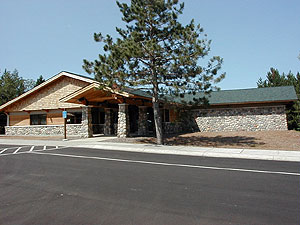|
Audio
Photos
Resources
Your Voice
|
State Parks muddle through budget cuts
July 28, 2003
Minnesotans are in love with their State Parks. Visitor numbers are high again this summer. Many campgrounds will fill each night through mid-August. The DNR has worked hard to keep campgrounds open and services intact, despite taking a big hit in the parks budget. Visitors may see little difference this year, but officials worry that parks will begin showing wear if tight budgets continue.
Moose Lake, Minn. — Clarence Larson is a big fan of Minnesota State Parks. The Minneapolis retiree and his wife bring their camper to several parks each year. On this day, they're at Moose Lake State Park - a quiet northeast Minnesota hide-away just off I-35. Larson's noticed one change. As senior citizens, the couple used to get into the park for less money.
 | |||
"They're charging seniors now. See, seniors used to go Monday through Thursday for half price," Larson says.
It costs everybody a little more this summer to get into Minnesota's State Parks. But, Larson understands the park system's predicament.
"The budget is low, so it's well worth while," he says. "The parks are so nice I don't mind paying. It's well worth it."
Even with increased fees, the Department of Natural Resources budget for parks has been cut about $3 million - that's seven percent less than last year. Meanwhile, the Parks Division has been given responsibility for more than 40 additional campgrounds in State Forests.
 | |||
Park visitors can expect to see a little less of the park staff. The time workers spend with the public - called contact hours - has been cut. Entry gates open a little later and close a little earlier. The park's division has trimmed 30 full time workers and dozens of seasonal employees.
Moose Lake State Park has just opened its new visitor center, with a state geology and agate interpretive wing. Moose Lake Park Director Don DelGreco, says the center has ample space for research and education. But it's a little under-staffed. There's no money in the budget for a park naturalist.
"This building was designed to house and to provide an interpretive naturalist, at some point in time," DelGreco says. "To fulfill the longer term educational mission, of this state park, a naturalist will be a missing piece for at least the immediate future."
 | |||
Resource management will get put off. The non-native Ginnala Maples around Moose Lake's beach and campgrounds will be left in place until the park can afford to pull them out. There will be less mowing and painting at parks across the state.
Still, DelGreco says a tight budget's not keeping the public away.
"We are seeing an increase in our day use, but our campground use has been increasing over the last five to ten years," he says.
Moose Lake's campground closed early last year. But not this year. The Department of Natural Resources has vowed to keep campgrounds open beyond Labor Day. But the grass might be a bit overgrown, and there might not be anyone staffing the front gate.
 | |||
On the surface, budget cuts may not be that evident. But park managers worry about the future. DelGreco says a park can erode, much like an unprotected hillside.
"There are facilities to maintain," DelGreco says. "There's long term infrastructure needs in our State Parks system. Within the current budget we will try to do as much of that as we can, but we know that at some point in time there will be some erosion of our services, and possibly some erosion of our facilities," he says.
Many parks are getting a long needed overhaul this summer, thanks to a $23 million appropriation in last year's state bonding bill. But park managers are still playing catch-up.
There are 1,600 state park buildings; more than 600 on the National Register of Historic Places. Parks Director Bill Morrissey says long-term maintenance is a concern.
"It takes a lot of effort and a lot of money to keep those up," Morrissey says. "You know, if you keep up with the routine maintenance, you don't have the larger costs building up. We haven't been able to do that."
Morrissey says the public can help the parks deal with the budget.
"If visitors get on the internet, and they get their map, and maybe they call us for some information here at DNR - maybe a little more self-reliant - maybe help us by taking home some of the garbage that's generated during a camping trip, I think they're going to have a great time out there, and probably won't notice the services have been cut," Morrisey says.
The budget could improve, with increased vehicle admission sales and camping fees. Officials say, the best way to help Minnesota State Parks might be to visit one.
|
News Headlines
|
Related Subjects
|

